Gender and Social Seed Networks for Climate Change Adaptation: Evidence from Bean, Finger Millet, and Sorghum Seed Systems in East Africa
Abstract
1. Introduction
2. Informal Seed Networks in East Africa
Gender Dimensions of Seed Networks
3. Materials and Methods
3.1. Use of Social Network Analysis for the Study of Seed Systems
3.2. Study Sites
3.3. Survey Methods and Focus Group Discussions
3.4. Data Analysis
4. Results
4.1. Farmer Characteristics by Gender
4.2. Farmers’ Access to Information Sources
4.3. Climate Change and Adaptation Strategies
4.4. Social Seed Networks by Gender
4.5. Climate Change Adaption Varieties by Gender
5. Discussion
6. Conclusions
Author Contributions
Funding
Institutional Review Board Statement
Informed Consent Statement
Data Availability Statement
Acknowledgments
Conflicts of Interest
Appendix A
| Climate Change Perception | Gender | Lower Nyando, Kenya | Upper Nyando, Kenya | Hombolo, Tanzania | Singida, Tanzania | Hoima, Uganda |
|---|---|---|---|---|---|---|
| Experienced climate change impacts | Male | 98.2% | 96.7% | 100.0% | 87.5% | 90.1% |
| Female | 98.3% | 90.9% | 100.0% | 91.5% | 90.7% | |
| Shifting seasons | Male | 98.2% | 92.3% | 100.0% | 96.8% | 90.8% |
| Female | 97.4% | 90.9% | 80.0% | 96.5% | 93.9% | |
| Short rains | Male | 98.2% | 95.6% | 90.0% | 93.7% | 100.0% |
| Female | 98.3% | 90.9% | 97.1% | 95.3% | 95.8% | |
| Heavy rains | Male | 98.2% | 95.6% | 40.0% | 14.3% | 81.7% |
| Female | 97.4% | 90.9% | 34.3% | 93.0% | 83.0% | |
| Erratic rains | Male | 98.2% | 95.6% | 100.0% | 92.1% | 90.0% |
| Female | 95.7% | 90.9% | 94.3% | 95.3% | 84.2% | |
| Flooding | Male | 89.1% | 69.2% | 40.0% | 12.7% | 49.5% |
| Female | 91.5% | 39.4% | 45.7% | 17.4% | 41.2% | |
| Drought | Male | 98.2% | 96.7% | 100.0% | 98.4% | 100.0% |
| Female | 98.3% | 90.9% | 100.0% | 97.7% | 99.3% | |
| Increased temperatures | Male | 98.2% | 95.6% | 30.0% | 69.8% | 98.2% |
| Female | 98.3% | 90.9% | 60.0% | 82.6% | 99.3% | |
| Pests and diseases | Male | 98.2% | 92.3% | 70.0% | 98.4% | 93.6% |
| Female | 94.0% | 87.9% | 88.6% | 100.0% | 96.4% | |
| Wind | Male | 87.3% | 79.1% | 90.0% | 93.7% | 88.1% |
| Female | 86.3% | 77.8% | 94.3% | 97.7% | 92.7% |
References
- FAO. Sex-Disaggregated Data in Agriculture and Sustainable Resource Management: New Approaches for Data Collection and Analysis; FAO: Rome, Italy, 2019.
- Quisumbing, A.R.; Meinzen-Dick, R.; Raney, T.L.; Croppenstedt, A.; Behrman, J.A.; Peterman, A. Gender in Agriculture: Closing the Knowledge Gap; Springer Science & Business: Dordrecht, The Netherlands, 2014. [Google Scholar]
- Peterman, A.; Quisumbing, A.; Berhman, J.; Nkonya, E. Understanding the complexities surrounding gender differences in agricultural productivity in Nigeria and Uganda. J. Dev. Stud. 2011, 47, 1482–1509. [Google Scholar] [CrossRef]
- Koppmair, S.; Kassie, M.; Qaim, M. The influence of farm input subsidies on the adoption of natural resource management technologies. Aust. J. Agric. Resour. Econ. 2017, 61, 539–556. [Google Scholar] [CrossRef]
- Salami, A.; Kamara, A.B.; Brixiova, Z. Smallholder Agriculture in East Africa: Trends, Constraints and Opportunities; African Development Bank: Tunis, Tunisia, 2010. [Google Scholar]
- FAO; IFAD; UNICEF; WFP; WH. The State of Food Security and Nutrition in the World 2018: Building Climate Resilience for Food Security and Nutrition; FAO: Rome, Italy, 2018.
- IFAD. Rural Development Report 2016: Fostering Inclusive Rural Transformation; IFAD: Rome, Italy, 2016. [Google Scholar]
- Niles, M.T.; Salerno, J. A cross country analysis of climate shocks on smallholder food insecurity. PLoS ONE 2018, 13, e0195405. [Google Scholar] [CrossRef]
- Ombogoh, D.B.; Tanui, J.; McMullin, S.; Muriuki, J.; Mowo, J. Enhancing adaptation to climate variability in the East African highlands: A case for fostering collective action among smallholder farmers in Kenya and Uganda. Clim. Dev. 2016, 10, 61–72. [Google Scholar] [CrossRef]
- Ampaire, E.L.; Jassogne, L.; Providence, H.; Acosta, M.; Twyman, J.; Winowiecki, L.; van Asten, P. Institutional challenges to climate change adaptation: A case study on policy action gaps in Uganda. Environ. Sci. Policy 2017, 75, 81–90. [Google Scholar] [CrossRef]
- Cooper, S.J.; Wheeler, T. Rural household vulnerability to climate risk in Uganda. Reg. Environ. Chang. 2017, 17, 649–663. [Google Scholar] [CrossRef]
- Jost, C.; Kyazze, F.; Naab, J.; Neelormi, S.; Kinyangi, J.; Zougmore, R.; Aggarwal, P.; Bhatta, G.; Chaudhury, M.; Tapio-Bistrom, M.L.; et al. Understanding gender dimensions of agriculture and climate change in smallholder farming communities. Clim. Dev. 2016, 8, 133–144. [Google Scholar] [CrossRef]
- Tiyo, C.E.; Orach-Meza, F.L.; Edroma, E.L. Understanding small-scale farmers’ perception and adaptation strategies to climate change impacts: Evidence from two agro-ecological zones bordering national parks of Uganda. J. Agric. Sci. 2015, 7, 253–270. [Google Scholar]
- Okonya, J.S.; Syndikus, K.; Kroschel, J. Farmers’ perception of and coping strategies to climate change: Evidence from six agro-ecological zones of Uganda. J. Agric. Sci. 2013, 5, 252–563. [Google Scholar] [CrossRef]
- Adhikari, U.; Nejadhashemi, P.A.; Woznicki, S. A climate change and East Africa: A review of impacts on major crops. Food Energy Secur. 2015, 4, 110–132. [Google Scholar]
- Doss, C.; Meinzen-Dick, R.; Quisumbing, A.; Theis, S. Women in agriculture: Four myths. Glob. Food Secur. 2018, 16, 69–74. [Google Scholar] [CrossRef]
- Progressio (Ed.) Seed Saving and Climate Change in Zimbabwe; Progressio: London, UK, 2009. [Google Scholar]
- Westengen, O.T.; Brysting, A.K. Crop adaptation to climate change in the semi-arid zone in Tanzania: The role of genetic resources and seed systems. Agric. Food Secur. 2014, 3, 3. [Google Scholar] [CrossRef]
- Altieri, M.A.; Funes-Monzote, F.R.; Peterson, P. Agroecologically efficient agricultural systems for smallholder farmers: Contributions to food security. Agron. Sustain. Dev. 2012, 32, 1–13. [Google Scholar] [CrossRef]
- McGuire, S.; Sperling, L. Making seed systems more resilient to stress. Glob. Environ. Chang. 2013, 23, 644–653. [Google Scholar] [CrossRef]
- Anderson, C.L.; Reynolds, T.W.; Biscaye, P.; Patwardan, V.; Schmidt, C. Economic benefits of empowering women in agriculture: Assumptions and evidence. J. Dev. Stud. 2020, 1–16. [Google Scholar] [CrossRef]
- Reynolds, T.W.; Tobin, D.; Otieno, G.; McCracken, A.; Guo, J. Differences in crop selection, resource constraints, and crop use values among female- and male-headed smallholder households in Kenya, Tanzania, and Uganda. J. Agric. Food Syst. Community Dev. 2020, 9, 1–28. [Google Scholar]
- CTA. Seed Systems, Science, and Policy in East and Central Africa; The Technical Centre for Agricultural and Rural Cooperation: Wageningen, The Netherlands, 2015; Available online: https://www.asareca.org/publication/seed-systems-science-and-policy-east-and-central-africa (accessed on 1 February 2021).
- Louwaars, N.P.; de Boef, W.S.; Edeme, J. Integrated seed sector development in Africa: A basis for seed policy and law. J. Crop Improv. 2013, 27, 186–214. [Google Scholar] [CrossRef]
- Rachkara, P.; Phillips, D.P.; Kalule, S.W.; Gibson, R.W. Innovative and beneficial informal sweetpotato private enterprise in northern Uganda. Food Secur. 2017, 9, 595–610. [Google Scholar] [CrossRef]
- Otieno, G.; Lacasse, H.; Fadda, C.; Reynolds, T.W.; Recha, J.W. Social Seed Networks for Climate Change Adaptation in Western Kenya; CCAFS Info Note; CGIAR Research Program on Climate Change, Agriculture and Food Security (CCAFS): Wageningen, The Netherlands, 2018; Available online: https://cgspace.cgiar.org/handle/10568/93210 (accessed on 1 February 2021).
- Bellon, M.R.; Hodson, D.; Hellin, J. Assessing the vulnerability of traditional maize seed systems in Mexico to climate change. Proc. Natl. Acad. Sci. USA 2011, 108, 13432–13437. [Google Scholar] [CrossRef] [PubMed]
- Hellin, J.; Bellon, M.R.; Hearne, S.J. Maize landraces and adaptation to climate change in Mexico. J. Crop Improv. 2014, 28, 484–501. [Google Scholar] [CrossRef]
- Otieno, G.; Mulumba, J.W.; Namulondo, B.; Halewood, M. Climate-Resilient Seed Systems & Access and Benefit-Sharing in Uganda; ISSD Africa: Kampala, Uganda, 2017. [Google Scholar]
- Food and Agricultural Organization of the United Nations (FAO); Rome, Italy, 2013. Available online: http://faostat.fao.org (accessed on 1 February 2021).
- O’Sullivan, M.; Rao, A.; Banerjee, R.; Gulati, K.; Vinez, M. Levelling the Field: Improving Opportunities for Women Farmers in Africa; World Bank: Washington, DC, USA, 2014. [Google Scholar]
- Tadesse, Y.; Almekinders, C.J.M.; Schulte, R.P.O.; Struik, P.C. Tracing the seed: Seed diffusion of improved potato varieties through farmers’ networks in Chencha, Ethiopia. Exp. Agric. 2016, 1–16. [Google Scholar] [CrossRef]
- Fisher, M.; Carr, E.R. The influence of gendered roles and responsibilities on the adoption of technologies that mitigate drought risk: The case of drought-tolerant maize seed in East Uganda. Glob. Environ. Chang. 2015, 35, 82–92. [Google Scholar] [CrossRef]
- McOmber, C.; Panikowski, A.; McKune, S.; Bartels, W.; Russo, S. Investigating Climate Information Services through a Gendered Lens. CCAFS Working Paper No. 42. 2013. Available online: https://cgspace.cgiar.org/handle/10568/27887 (accessed on 1 February 2021).
- FAO. The State of Food and Agriculture 2010–2011: Women in Agriculture; FAO: Rome, Italy, 2011.
- Coomes, O.T.; McGuire, S.J.; Garine, E.; Caillon, S.; McKey, D.; Demeulenaere, E.; Devra, J.; Guntra, A.; Adeline, B.; Pascal, C.; et al. Farmer seed networks make a limited contribution to agriculture? Four common misconceptions. Food Policy 2015, 56, 41–50. [Google Scholar] [CrossRef]
- Mucioki, M.; Johns, T.; Muriithi, C.; Hickey, G. The influence of gender roles and human migrations on the distribution of crop biodiversity in Tharaka, Kenya. J. Ethnobiol. 2016, 36, 172–191. [Google Scholar] [CrossRef]
- Pincus, L.; Croft, M.; Roothaert, R.; Dubois, T. African indigenous vegetable seed systems in western Kenya. Econ. Bot. 2018, 72, 380–395. [Google Scholar] [CrossRef]
- Violon, C.; Thomas, M.; Garine, E. Good year, bad year: Changing strategies, changing networks? A two-year study on seed acquisition in northern Cameroon. Ecol. Soc. 2016, 113, 98–103. [Google Scholar] [CrossRef]
- Pérez, C.; Jones, E.M.; Kristjanson, P.; Cramer, L.; Thornton, P.K.; Förch, W.; Barahona, C.A. How resilient are farming households and communities to a changing climate in Africa? A gender-based perspective. Glob. Environ. Chang. 2015, 34, 95–107. [Google Scholar] [CrossRef]
- Mudege, N.N.; Walsh, S. Gender and Roots Tubers and Bananas Seed Systems: A Literature Review; CGIAR Research Program on Roots, Tubers and Bananas (RTB), 2016. Available online: https://cgspace.cgiar.org/handle/10568/81051. (accessed on 1 February 2021).
- Nyberg, Y.; Jonsson, M.; Ambjörnsson, E.L.; Wetterlind, J.; Öborn, I. Smallholders’ awareness of adaptation and coping measures to deal with rainfall variability in Western Kenya. Agroecol. Sustain. Food Syst. 2020, 44, 1–29. [Google Scholar]
- Vasilaky, K. Female social networks and farmer training: Can randomized information exchange improve outcomes? Am. J. Agric. Econ. 2012, 95, 376–383. [Google Scholar] [CrossRef]
- Abay, F.; de Boef, W.; Bjørnstad, Å. Network analysis of barley seed flows in Tigray, Ethiopia: Supporting the design of strategies that contribute to on-farm management of plant genetic resources. Plant Genet. Resour. 2011, 9, 495–505. [Google Scholar] [CrossRef]
- Thomas, M.; Demeulenaere, E.; Dawson, J.C.; Khan, A.R.; Galic, N.; Jouanne-Pin, S.; Remoue, C.; Bonneuil, C.; Goldringer, I. On-farm dynamic management of genetic diversity: The impact of seed diffusions and seed saving practices on a population-variety of bread wheat. Evol. Appl. 2012, 5, 779–795. [Google Scholar] [CrossRef]
- Ricciardi, V. Social seed networks: Identifying central farmers for equitable seed access. Agric. Syst. 2015, 139, 110–121. [Google Scholar] [CrossRef]
- McGuire, S. Securing access to seed: Social relations and sorghum seed exchange in East Ethiopia. Hum. Ecol. 2008, 36, 217–229. [Google Scholar] [CrossRef]
- Pautasso, M.; Aistara, G.; Barnaud, A.; Caillon, S.; Clouvel, P.; Coomes, O.T.; Tramontini, S. Seed exchange networks for agrobiodiversity conservation. A review. Agron. Sustain. Dev. 2013, 33, 151–175. [Google Scholar] [CrossRef]
- Poudel, D.; Bhuwon, S.; Shrestha, P. An analysis of social seed network and its contribution to on-farm conservation of crop genetic diversity in Nepal. Int. J. Biodivers. 2015, 1–13. [Google Scholar] [CrossRef] [PubMed]
- Krebs, V. An Introduction to Social Network Analysis. 2005. Available online: http://www.orgnet.com/sna.html (accessed on 1 February 2021).
- Hanemann, R.A.; Riddle, M. Introduction to Social Network Methods; University of California: Riverside, CA, USA, 2005. Available online: http://faculty.ucr.edu/~hanneman/ (accessed on 1 February 2021).
- Salpeteur, M.; Calvet-Mir, L.; Diaz-Reviriego, I.; Reyes-García, V. Networking the environment: Social network analysis in environmental management and local ecological knowledge studies. Ecol. Society 2017, 22, 1–6. [Google Scholar]
- Rufino, M.C.; Hengsdijk, H.; Verhagen, A. Analyzing integration and diversity in agro ecosystems by using indicators of network analysis. Nutr. Cycl. Agroecosystems 2009, 84, 229–247. [Google Scholar] [CrossRef]
- Thuo, M.; Bell, A.A.; Bravo-Ureta, B.E.; Okello, D.K.; Okoko, E.N.; Kidula, N.L.; Deom, C.M.; Puppala, N. Social networking structures among groundnut farmers. J. Agric. Educ. Ext. 2013, 19, 339–359. [Google Scholar] [CrossRef]
- FAO; International Fund for Agricultural Development (IFAD); UNICEF; WFP (World Food Program); World Health Organization (WHO). The State of Food Security and Nutrition in the World: Safeguarding against Economic Slowdowns and Downturns. 2019. Available online: http://www.fao.org/publications/sofi/en/ (accessed on 1 February 2021).
- Lovo, S.; Veronesi, M. Crop diversification and child health: Empirical evidence from Tanzania. Ecol. Econ. 2019, 158, 168–179. [Google Scholar] [CrossRef]
- Amato, F.; Moscato, V.; Picariello, A.; Sperlí, G. Multimedia social network modeling: A proposal. In 2016 IEEE Tenth International Conference on Semantic Computing (ICSC); IEEE: Laguna Hills, CA, USA, 2016; pp. 448–453. [Google Scholar]
- Amato, F.; Moscato, V.; Picariello, A.; Sperlí, G. Diffusion algorithms in multimedia social networks: A preliminary model. In Proceedings of the 2017 IEEE/ACM International Conference on Advances in Social Networks Analysis and Mining, Sydney, Australia, 31 July–3 August 2017; pp. 844–851. [Google Scholar]
- Gathungu, G.K.; Aguyoh, J.N.; Isutsa, D.K. Effects of Integration of irrigation water and mineral nutrient management in seed potato (Solanum Tuberosum L.) production on water, nitrogen and phosphorus use efficiencies. In Adapting African Agriculture to Climate Change: Transforming Rural Livelihoods; Filho, W.L., Esilaba, A.O., Rao, K.P.C., Sridhar, G., Eds.; Springer International Publishing: Berlin/Heidelberg, Germany, 2015; pp. 171–183. [Google Scholar] [CrossRef]
- Midega, C.A.O.; Bruce, T.J.A.; Pickett, J.A.; Pittchar, J.O.; Murage, A.; Khan, Z.R. Climate adapted companion cropping increases agricultural productivity in East Africa. Field Crop. Res. 2015, 180, 118–125. [Google Scholar] [CrossRef]
- Cairns, J.E.; Hellin, J.; Sonder, K.; Araus, J.L.; MacRobert, J.F.; Thierfelder, C.; Prasanna, B.M. Adapting maize production to climate change in sub-Saharan Africa. Food Secur. 2013, 5, 345–360. [Google Scholar] [CrossRef]
- Martin, T.; Biruma, M.; Fogelqvist, J.; Okori, P.; Dixelius, C. Unlocking the potential of sorghum for development in East Africa. In Sorghum: Production, Growth Habits and Health Benefits; Nova: Hauppauge, NY, USA, 2013; pp. 45–65. [Google Scholar]
- Deressa, T.T.; Hassan, R.M.; Ringler, C.; Alemu, T.; Yesuf, M. Determinants of farmers’ choice of adaptation methods to climate change in the Nile Basin of Ethiopia. Glob. Environ. Chang. 2009, 19, 248–255. [Google Scholar] [CrossRef]
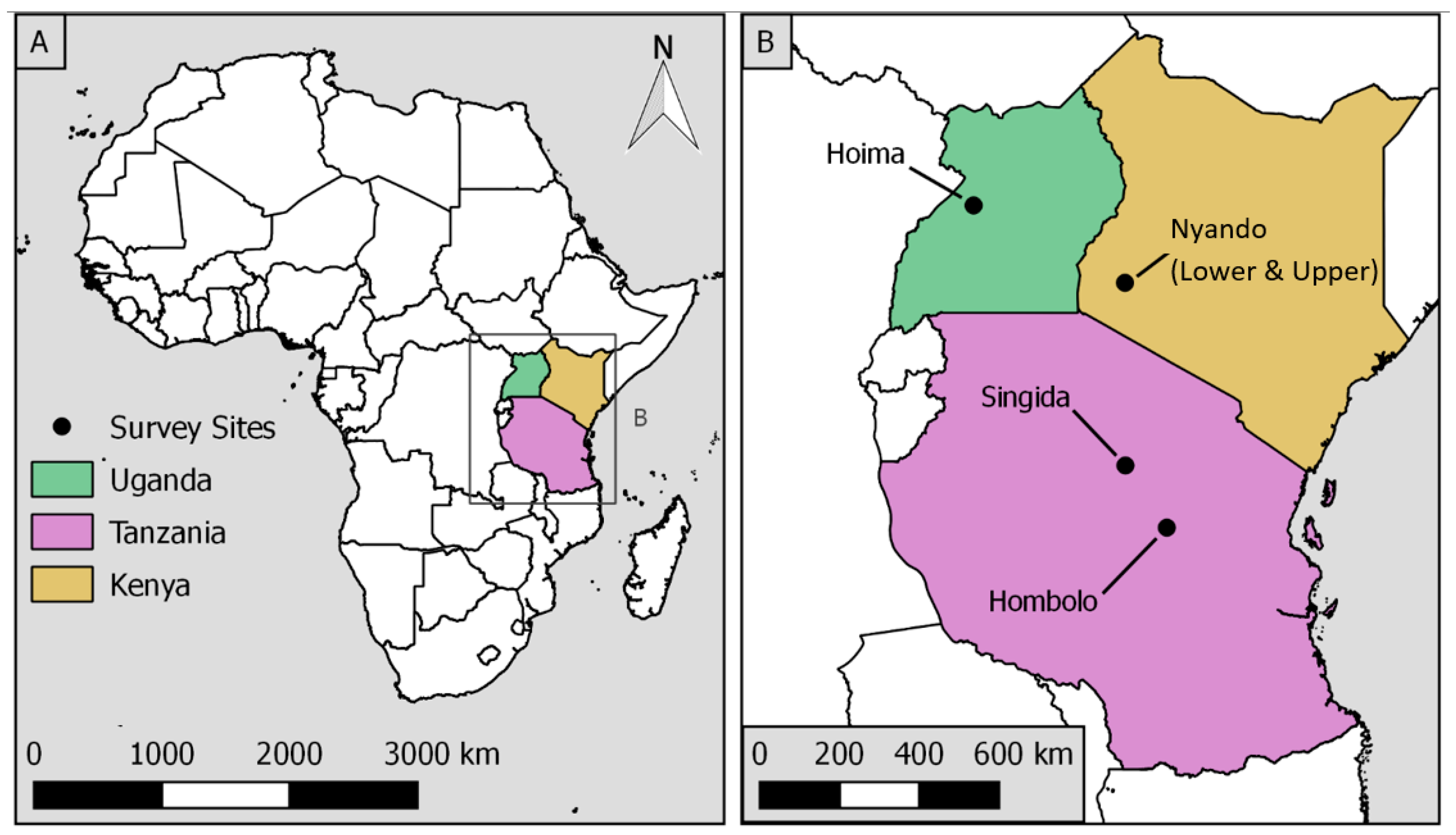
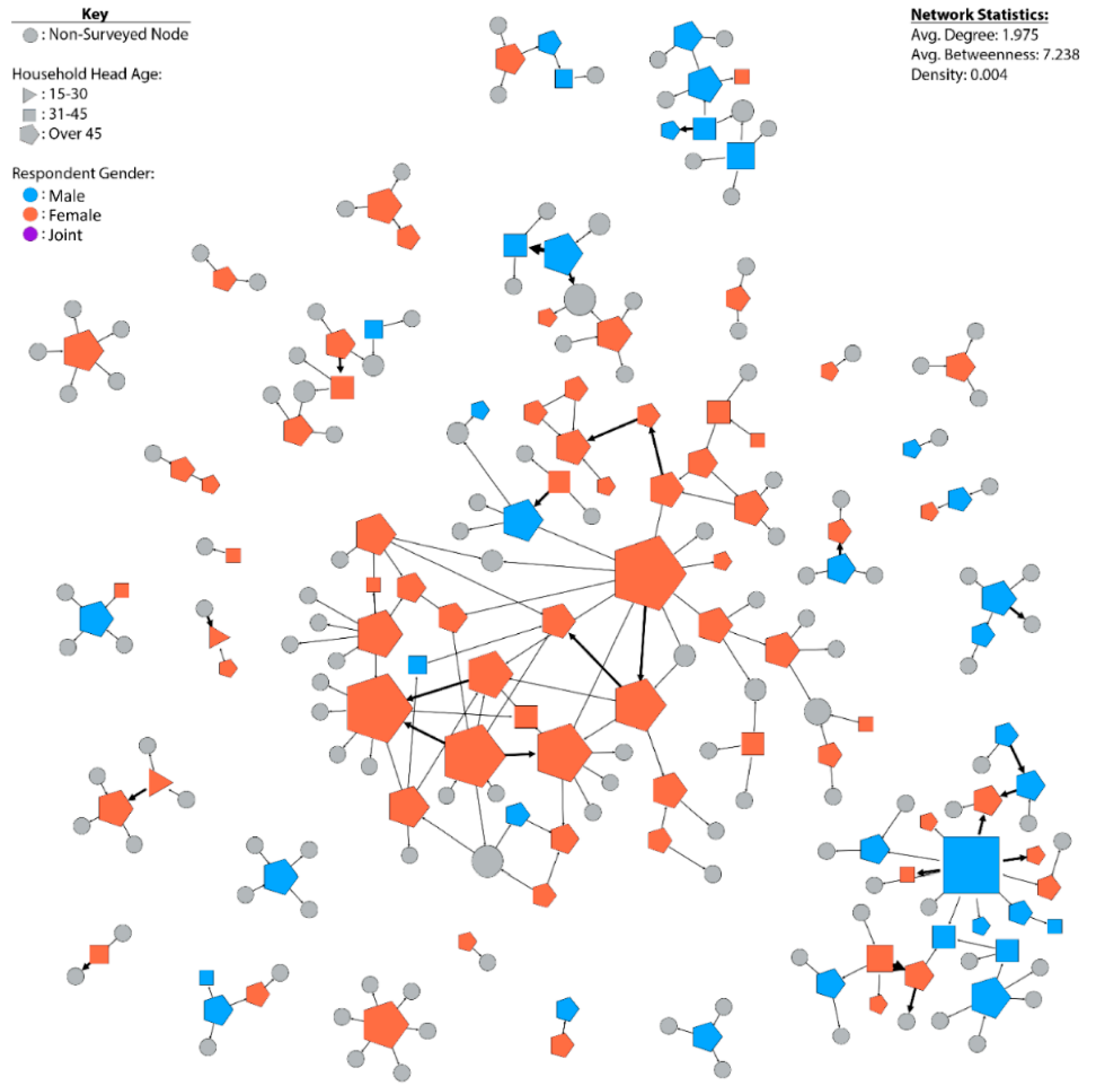
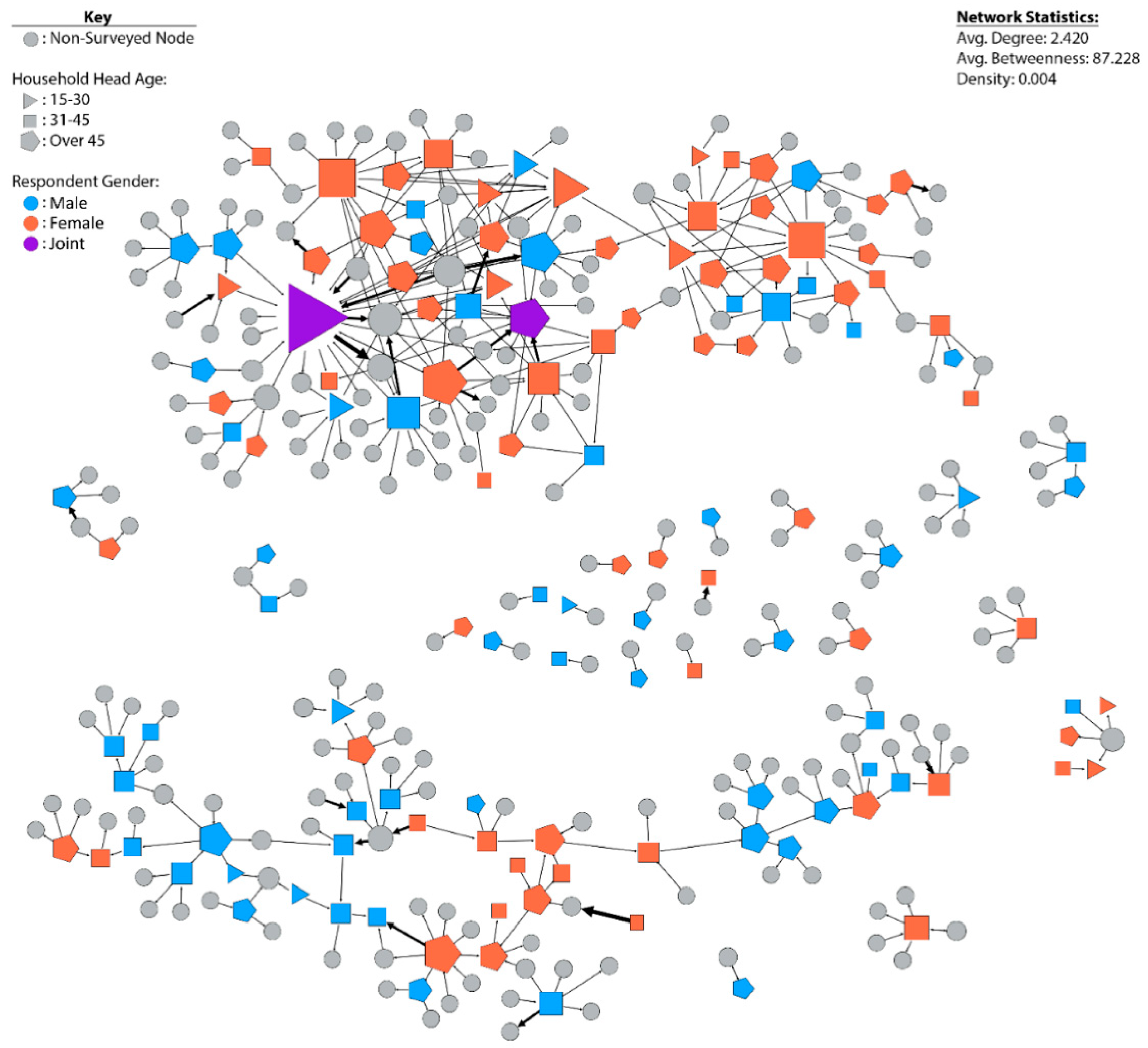

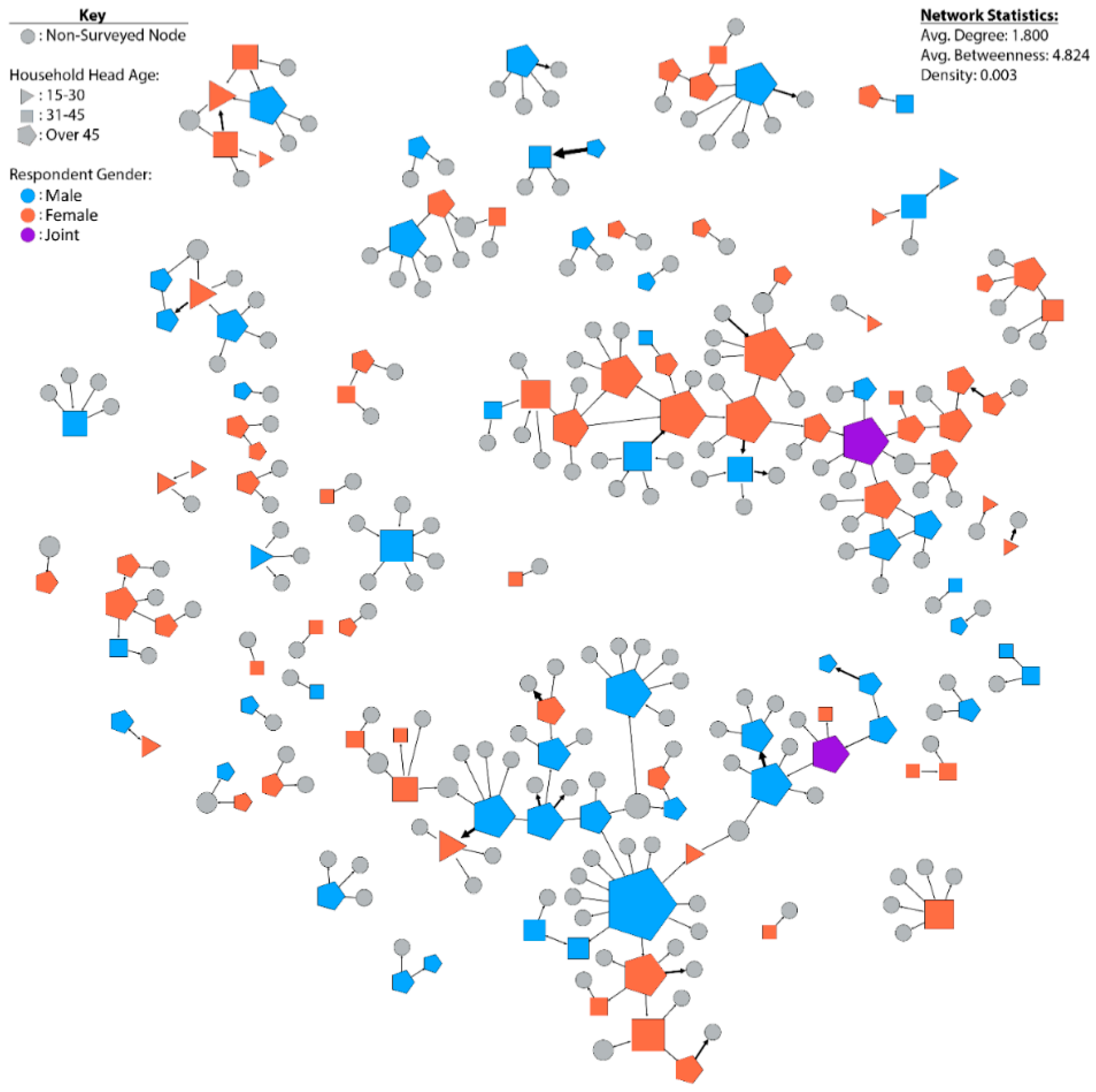
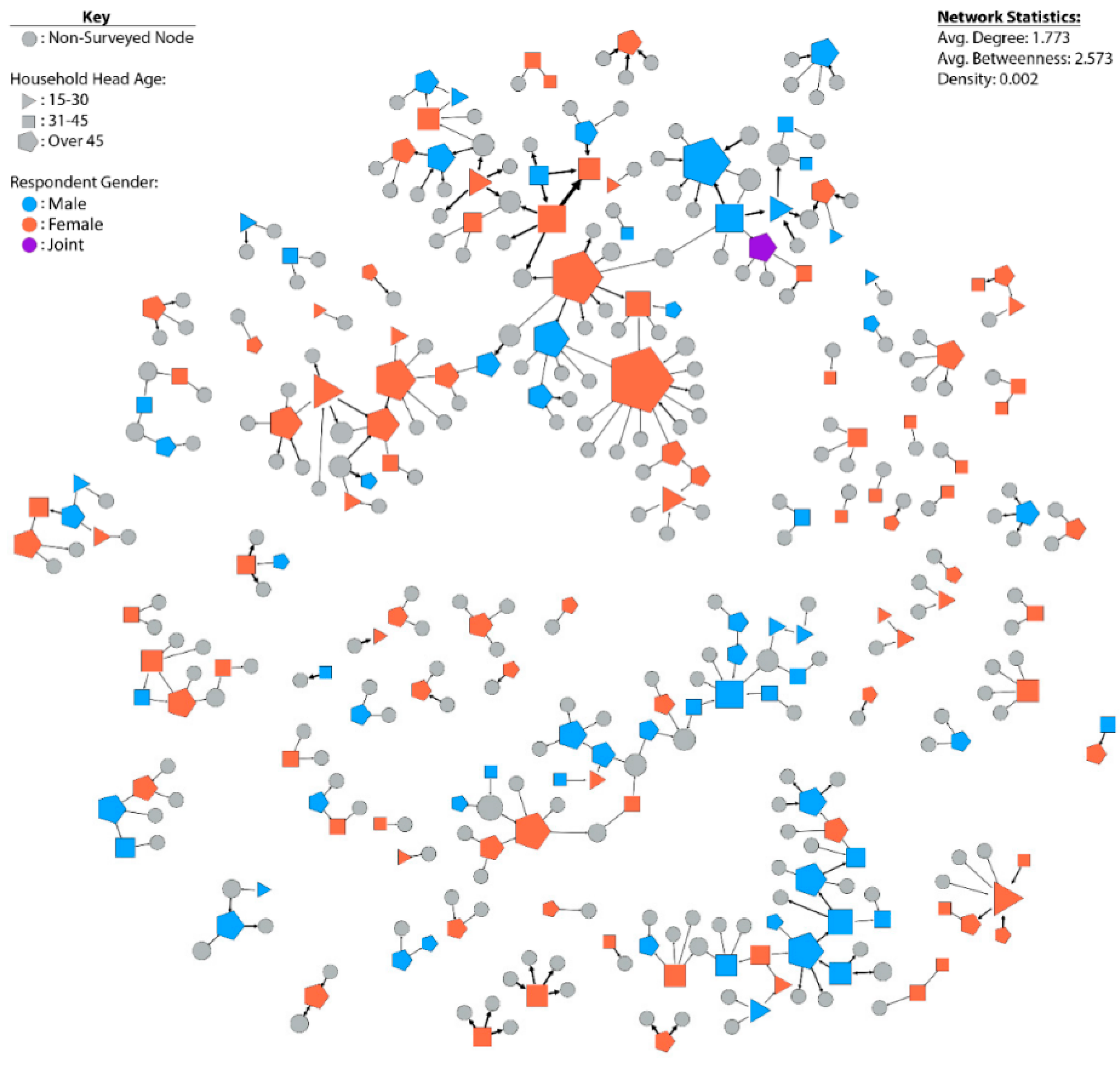
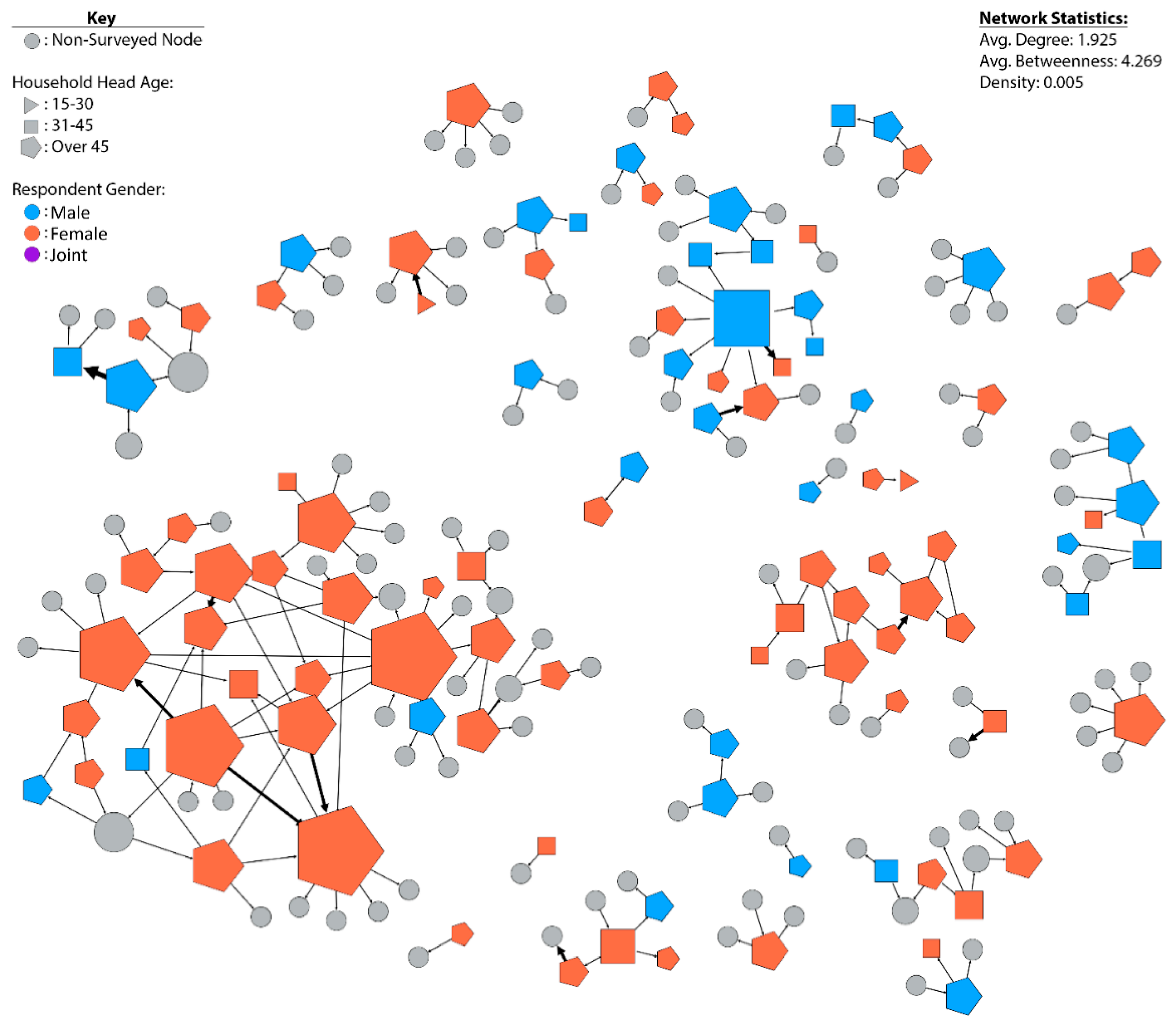
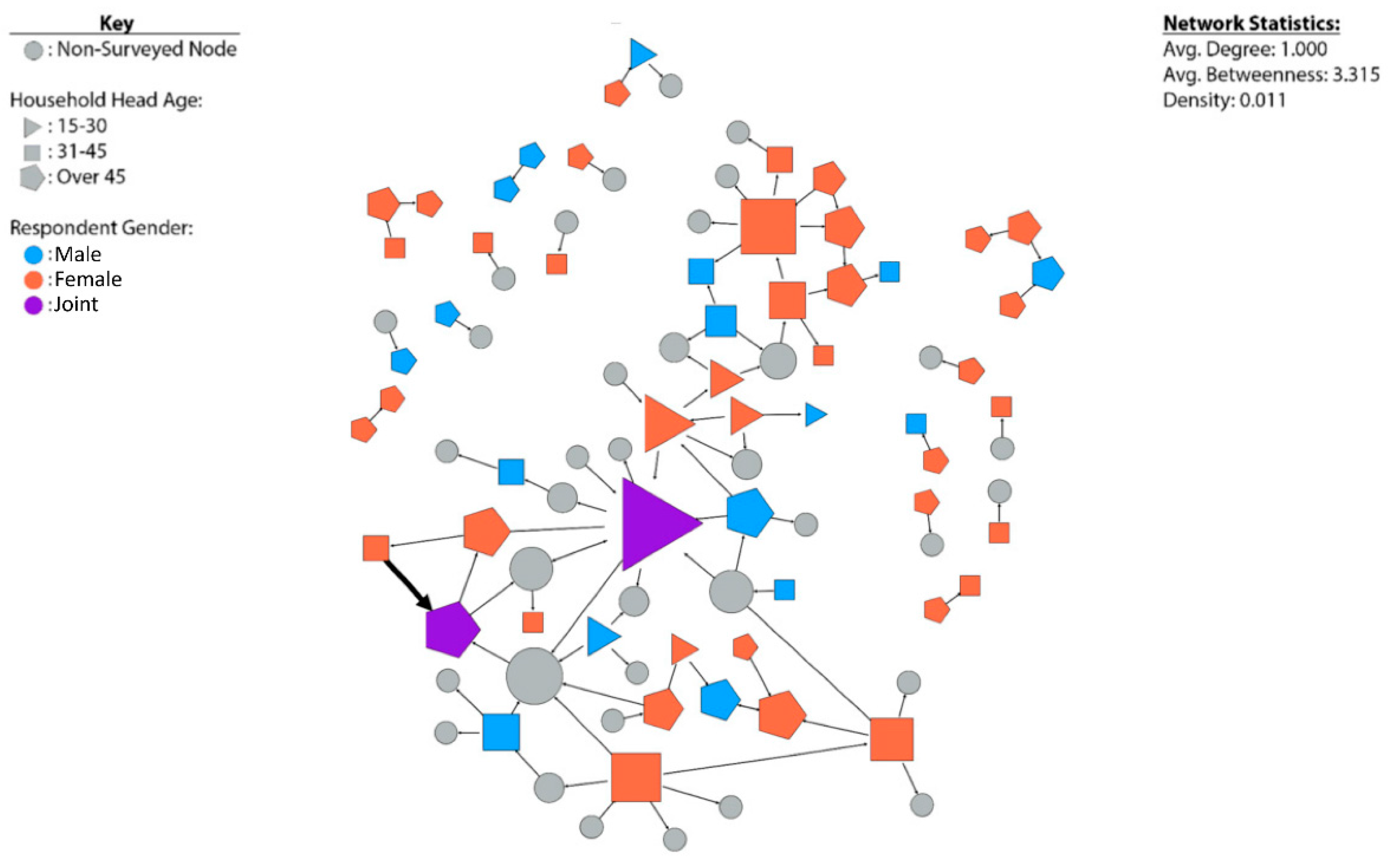
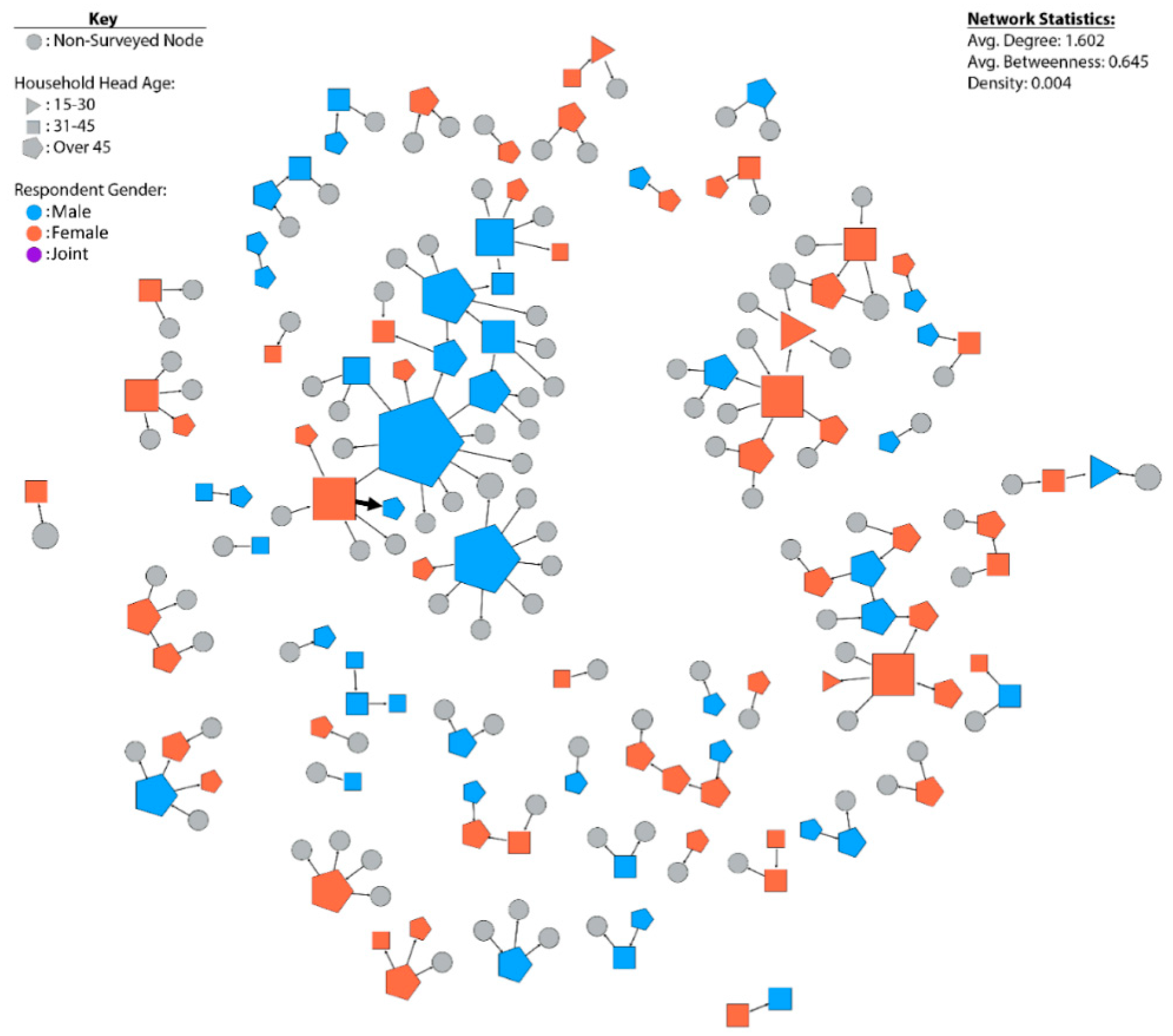
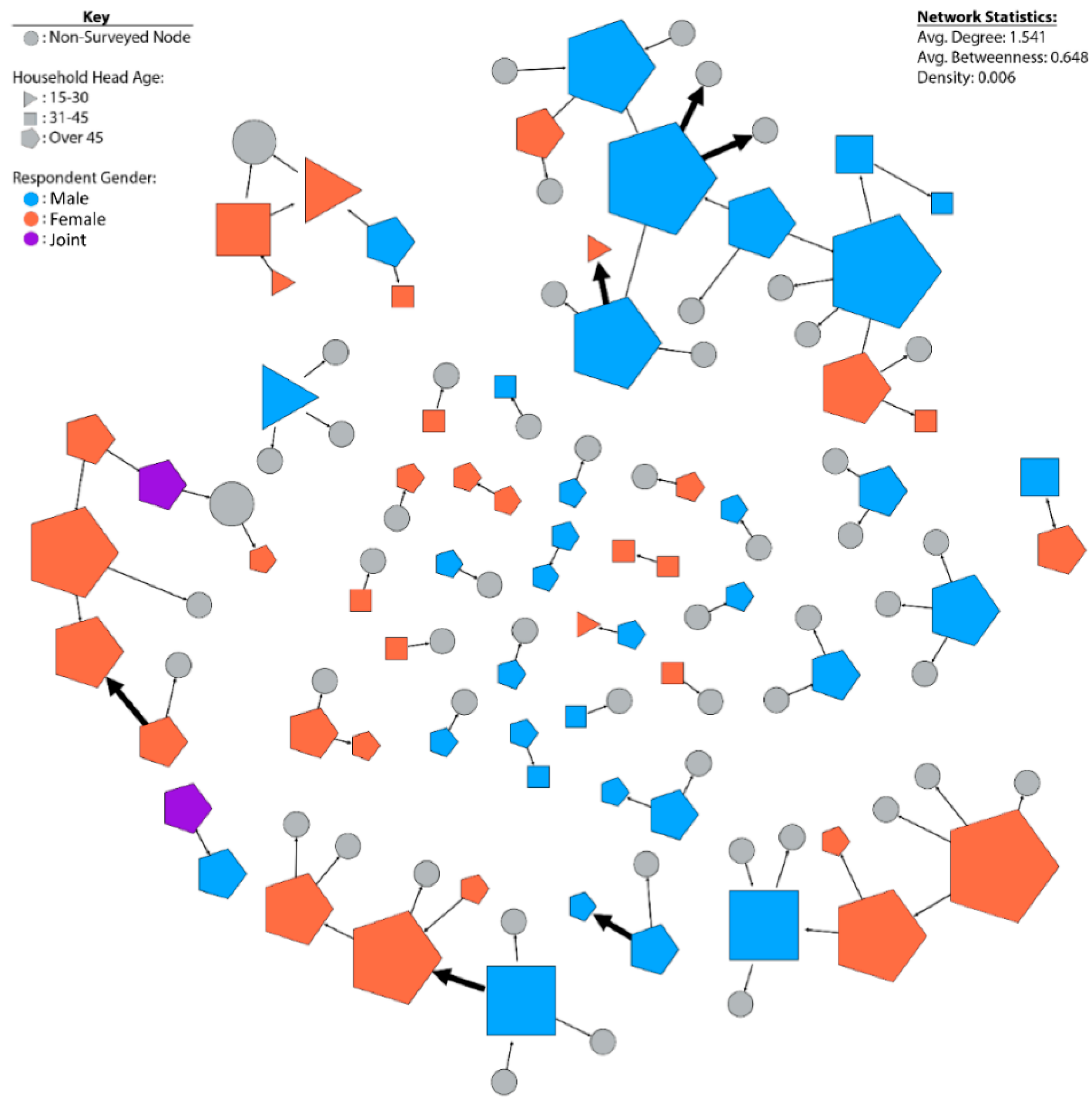
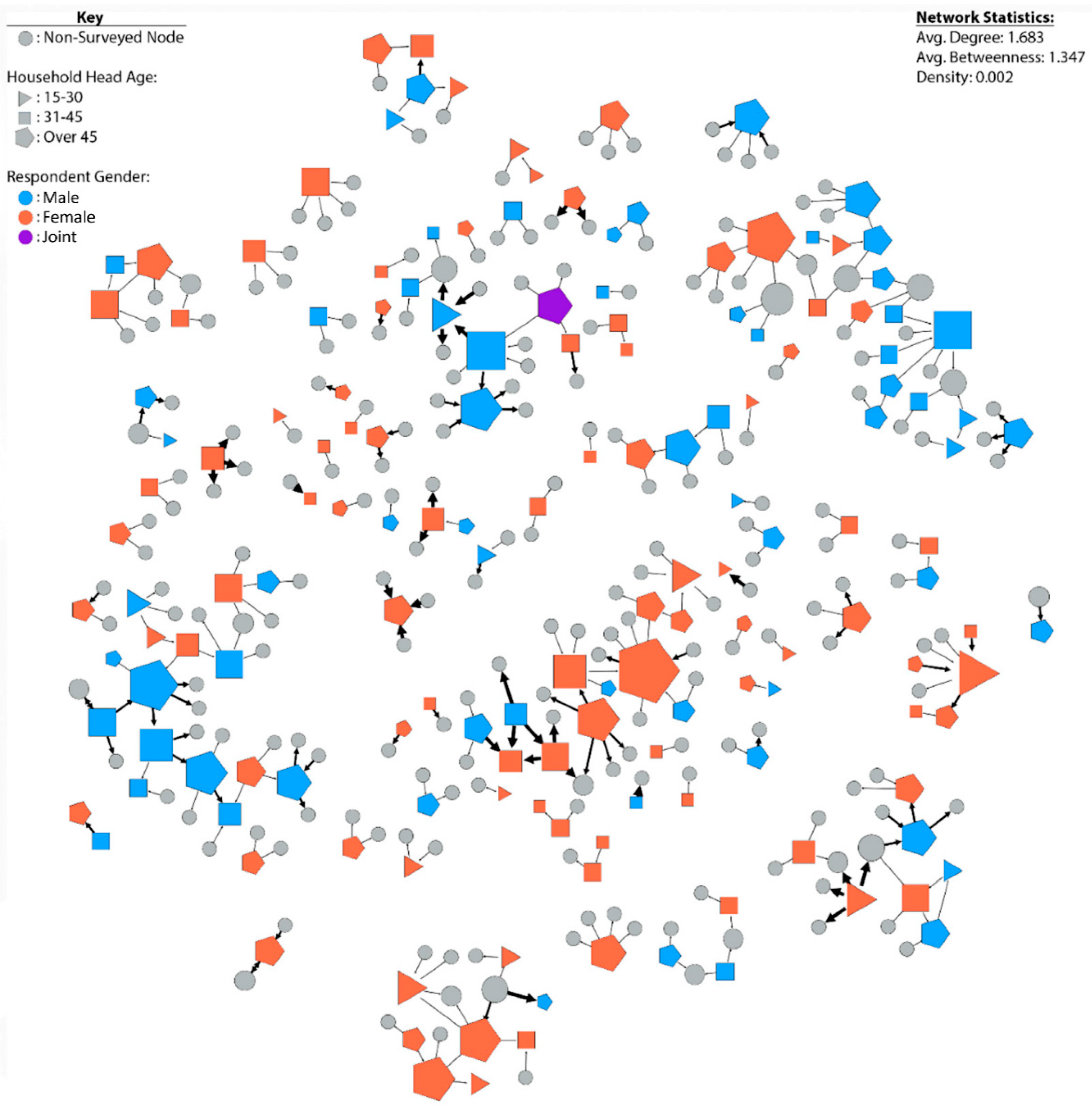
| Lower Nyando, Kenya | Upper Nyando, Kenya | Hombolo, Tanzania | Singida, Tanzania | Hoima, Uganda | |
|---|---|---|---|---|---|
| Farming system | Mixed subsistence | Mixed subsistence to commercial | Mixed subsistence | Mixed subsistence | Mixed subsistence |
| Agro-ecology | Semi-arid to Sub humid | Sub-humid | Semi-arid | Semi-arid to Sub humid | Sub-humid |
| Average rainfall (mm) | 800 | 1220 | 400 | 600 | 1200 |
| Temperature (°C) | 18–34 | 12–30 | 12–35 | 12–30 | 12–32 |
| Altitude (MASL) | 1100–1300 | 1200–1400 | 1100 | 1500 | 1120 |
| Market access | Very good | Very good | Poor | Moderate | Very good |
| One or More Expert Connections | ||||
|---|---|---|---|---|
| Overall % (Count) | Men % of Men (Count) | Women % of Women (Count) | ||
| Kenya | Lower Nyando | 28.3% (49) | 43.6% (24) | 21.2% (25) |
| Upper Nyando | 41.9% (80) | 37.0% (34) | 46.5% (46) | |
| Tanzania | Hombolo | 15.5% (26) | 32.9% (23) | 3.1% (3) |
| Singida | 9.6% (16) | 13.9% (10) | 6.4% (6) | |
| Uganda | Hoima | 10.2% (31) | 10.7% (13) | 9.9% (18) |
| Adapting Using New/Varied Seed | |||||
|---|---|---|---|---|---|
| Study Site | Lower Nyando | Upper Nyando | Hombolo | Singida | Hoima |
| Any adaptation with seed reported | 57.2% (99) | 2.6% (5) | 51.2% (86) | 4.8% (8) | 23.4% (71) |
| Adaptation with seed among men | 83.6% (46) | 4.3% (4) | 60% (42) | 6.9% (5) | 20.7% (25) |
| Adaptation with seed among women | 44.9% (53) | 1% (1) | 44.9% (44) | 3.2% (3) | 25.3% (46) |
| Adaptation by age of household head: | |||||
| 15–30 | 50% (2) | 0% (0) | 50% (4) | 5.9% (1) | 31.8% (14) |
| 41–45 | 72.7% (32) | 2.5% (2) | 38.9% (21) | 3.5% (2) | 26.1% (31) |
| Over 45 | 52% (66) | 3.5% (3) | 57.5% (61) | 5.6% (5) | 18.4% (25) |
| Adaptation by education of household head: | |||||
| Less than primary education | 0% (0) | 1% (1) | 34% (16) | 3.8% (2) | 9.1% (8) |
| Primary education or more | 62.3% (99) | 4.3% (4) | 57.9% (70) | 5.3% (6) | 29.9% (63) |
| Density and Participation | Average Degree Centrality | Average Betweenness | |||||||||
|---|---|---|---|---|---|---|---|---|---|---|---|
| Density | Men | Women | All | Men | Women | T-Test p-Value | All | Men | Women | T-Test p-Value | |
| Lower Nyando | 0.004 | 36 | 72 | 1.975 | 2.917 | 3.056 | 0.725 | 7.238 | 3.250 | 20.806 | 0.005 |
| Sorghum | 0.005 | 35 | 69 | 1.925 | 2.486 | 2.899 | 0.230 | 4.269 | 1.657 | 11.072 | 0.010 |
| Red Sorghum | 0.016 | 15 | 12 | 1.364 | 1.667 | 1.417 | 0.374 | 0.182 | 0.333 | 0.167 | 0.453 |
| Upper Nyando | 0.004 | 62 | 71 | 2.420 | 3.919 | 4.141 | 0.707 | 87.228 | 136.292 | 226.442 | 0.244 |
| Sorghum | 0.005 | 35 | 48 | 1.523 | 1.914 | 1.833 | 0.802 | 0.665 | 1.371 | 1.021 | 0.595 |
| Hombolo | 0.004 | 49 | 60 | 1.652 | 2.510 | 2.083 | 0.220 | 0.848 | 2.347 | 1.250 | 0.161 |
| Sorghum | 0.004 | 47 | 59 | 1.602 | 2.298 | 2.034 | 0.426 | 0.645 | 1.426 | 1.169 | 0.601 |
| Macia | 0.005 | 28 | 46 | 1.634 | 2.857 | 1.891 | 0.047 | 0.601 | 1.964 | 0.804 | 0.096 |
| Singida | 0.003 | 55 | 71 | 1.800 | 3.164 | 2.634 | 0.133 | 4.823 | 9.673 | 12.099 | 0.647 |
| Sorghum | 0.006 | 35 | 33 | 1.541 | 2.029 | 1.848 | 0.542 | 0.648 | 1.057 | 1.212 | 0.797 |
| Naco Mtama 1 | 0.028 | 10 | 6 | 1.217 | 1.300 | 1.167 | 0.566 | 0.043 | 0.000 | 0.167 | 0.363 |
| Hoima | 0.002 | 67 | 96 | 1.773 | 2.672 | 2.625 | 0.866 | 2.573 | 6.463 | 5.010 | 0.496 |
| Beans | 0.002 | 67 | 92 | 1.683 | 2.493 | 2.380 | 0.609 | 1.347 | 4.119 | 2.174 | 0.134 |
| Seed Engufu | 0.004 | 31 | 51 | 1.492 | 2.065 | 2.059 | 0.984 | 0.575 | 1.613 | 1.118 | 0.513 |
| Exchanges by Men | Exchanges by Women | |||
|---|---|---|---|---|
| Men to/from Men | Men to/from Women | Women to/from Women | Women to/from Men | |
| Lower Nyando | 41.7% (15) | 58.3% (21) | 71.6% (53) | 28.4% (21) |
| Sorghum | 41.9% (13) | 58.1% (18) | 74.3% (52) | 25.7% (18) |
| Upper Nyando | 24.1% (19) | 75.9% (60) | 47.8% (55) | 52.2% (60) |
| Sorghum | 16% (4) | 84% (21) | 36.4% (12) | 63.6% (21) |
| Hombolo | 46.5% (20) | 53.5% (23) | 46.5% (20) | 53.5% (23) |
| Sorghum | 43.6% (17) | 56.4% (22) | 47.6% (20) | 52.4% (22) |
| Singida | 42.9% (21) | 57.1% (28) | 54.1% (33) | 45.9% (28) |
| Sorghum | 52.2% (12) | 47.8% (11) | 57.7% (15) | 42.3% (11) |
| Hoima | 43.1% (22) | 56.9% (29) | 50% (29) | 50% (29) |
| Beans | 43.8% (21) | 56.3% (27) | 48.1% (25) | 51.9% (27) |
| Site | Crop | Varieties | Overall % and Count of Farmers by Site | Men % and Count of Men by Site | Women % and Count of Women by Site |
|---|---|---|---|---|---|
| Lower Nyando | Any | Any Crop Used for Climate Adaptation | 57.2% (99) | 83.6% (46) | 44.9% (53) |
| Sorghum | Any Sorghum Variety Used | 56.6% (98) | 83.6% (46) | 44.1% (52) | |
| Red Sorghum (Improved) | 20.8% (36) | 41.8% (23) | 16.1% (19) | ||
| Andiwo (Local) | 12.1% (21) | 18.2% (10) | 9.3% (11) | ||
| Seredo (Improved) | 8.7% (15) | 10.9% (6) | 7.6% (9) | ||
| Upper Nyando | Any | Any Crop Used for Climate Adaptation | 2.6% (5) | 4.3% (4) | 1.0% (1) |
| Sorghum | Any Sorghum Variety Used | 2.6% (5) | 4.3% (4) | 1.0% (1) | |
| Gusneck (Improved) | 0.5% (1) | 1.1% (1) | 0.0% (0) | ||
| Cheplelilet (Local) | 0.5% (1) | 0.0% (0) | 1.0% (1) | ||
| Serena (Improved) | 0.5% (1) | 0.0% (0) | 1.0% (1) | ||
| Hombolo | Any | Any Crop Used for Climate Adaptation | 51.2% (86) | 60% (42) | 44.9% (44) |
| Sorghum | Any Sorghum Variety Used | 50.6% (85) | 58.6% (41) | 44.9% (44) | |
| Macia (Improved) | 39.9% (67) | 44.3% (31) | 36.7% (36) | ||
| Sandala (Local) | 1.8% (3) | 0.0% (0) | 3.1% (3) | ||
| Tegemeo (Improved) | 3.0% (5) | 2.9% (2) | 3.1% (3) | ||
| Singida | Any | Any Crop Used for Climate Adaptation | 4.8% (8) | 6.9% (5) | 3.2% (3) |
| Sorghum | Any Sorghum Variety Used | 4.2% (7) | 6.9% (5) | 2.1% (2) | |
| NACO Mtama 1 (Improved) | 2.4% (4) | 2.8% (2) | 2.1% (2) | ||
| Hakika (Improved) | 1.8% (3) | 4.2% (3) | 0.0% (0) | ||
| Macia (Improved) | 1.2% (2) | 2.8% (2) | 0.0% (0) | ||
| Hoima | Any | Any Crop Used for Climate Adaptation | 23.4% (71) | 20.7% (25) | 25.3% (46) |
| Beans | Any Bean Variety Used | 23.1% (70) | 20.7% (25) | 24.7% (45) | |
| Seed Engufu (Local) | 19.8% (60) | 17.4% (21) | 21.4% (39) | ||
| Kaita bahuru (Local) | 2.3% (7) | 0.8% (1) | 3.3% (6) | ||
| White beans (Improved) | 2.0% (6) | 4.1% (5) | 0.5% (1) |
Publisher’s Note: MDPI stays neutral with regard to jurisdictional claims in published maps and institutional affiliations. |
© 2021 by the authors. Licensee MDPI, Basel, Switzerland. This article is an open access article distributed under the terms and conditions of the Creative Commons Attribution (CC BY) license (http://creativecommons.org/licenses/by/4.0/).
Share and Cite
Otieno, G.; Zebrowski, W.M.; Recha, J.; Reynolds, T.W. Gender and Social Seed Networks for Climate Change Adaptation: Evidence from Bean, Finger Millet, and Sorghum Seed Systems in East Africa. Sustainability 2021, 13, 2074. https://doi.org/10.3390/su13042074
Otieno G, Zebrowski WM, Recha J, Reynolds TW. Gender and Social Seed Networks for Climate Change Adaptation: Evidence from Bean, Finger Millet, and Sorghum Seed Systems in East Africa. Sustainability. 2021; 13(4):2074. https://doi.org/10.3390/su13042074
Chicago/Turabian StyleOtieno, Gloria, Wesley Mlsna Zebrowski, John Recha, and Travis William Reynolds. 2021. "Gender and Social Seed Networks for Climate Change Adaptation: Evidence from Bean, Finger Millet, and Sorghum Seed Systems in East Africa" Sustainability 13, no. 4: 2074. https://doi.org/10.3390/su13042074
APA StyleOtieno, G., Zebrowski, W. M., Recha, J., & Reynolds, T. W. (2021). Gender and Social Seed Networks for Climate Change Adaptation: Evidence from Bean, Finger Millet, and Sorghum Seed Systems in East Africa. Sustainability, 13(4), 2074. https://doi.org/10.3390/su13042074








